Development moves so quickly in the early years, it can seem hard to keep up with all of the changes. These are some examples of what you could expect your little one to be doing typically at each age. This is not meant to diagnose delays, just provide you some examples of things you can expect at each age. If you have questions, contact your local speech language pathologist for advice.
0-3 Months
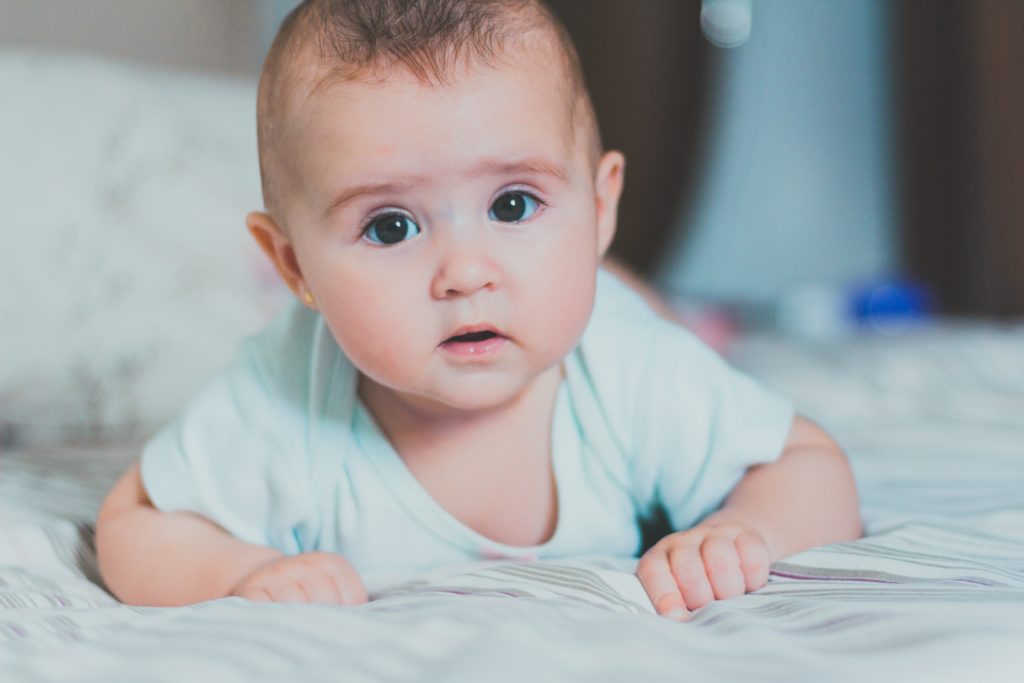
SOCIALIZING/PLAYING
- Has a social smile
- Establishes eye contact
- Likes to chew and pat books
- Follows a moving person with her eyes
- Smiles when she hears a voice or sees another smile
UNDERSTANDING
- Responds to voice and sound
- Soothed by calm and gentle voices
- Turns head toward sound source
- Startles with loud sounds
- Watches speaker’s face when spoken to
- Discriminates between strangers and familiar people
- Stops crying when spoken to
- Follows a toy (about 25 cm away) with eyes when the toy moves slowly (side to side or up and down) in front of baby’s face
- Waves arms toward a toy dangling above when lying on her back
TALKING
- Makes throaty or gurgling sounds
- Begins blowing bubbles
- Makes cooing sounds such as ‘ooo’, ‘gah’, ‘ahh’ (2 months)
- Makes sounds back at you when you speak to her
- Has different cries for different needs
- Cries in response to hunger
- Babbles to gain attention and indicate demand
- Smiles/coos at people (1 to 4 months)
EATING/SWALLOWING
- Baby seems to know it is feeding time when she sees breast or bottle
- Takes 2-4 ounces of liquid per feeding; 6 or more feedings per day (birth to 2 months)
- Takes 4-6 ounces of liquid per feeding; 6 or more feedings per day (2 to 3 months)
- Uses a suckling or sucking pattern; loses some liquid
- Swallows with suckle-swallow pattern; tongue may protrude slightly through lips with extension/retraction movement (i.e. suckle reflex and tongue thrust reflex)
- Sequences two or more sucks before pausing to swallow (older infants)
- Sucks fingers when near mouth
- Places hands on bottle during feeding
- Recognizes a nipple or bottle
- Pats a bottle with one or both hands Feeding takes no more than 25 minutes
CONTACT YOUR SPEECH LANGUAGE PATHOLOGIST IF YOU SEE
- Your baby does not respond to your smiles and interactions.
- Your baby is not responding to sound
- Your baby is not babbling
- Your baby is arching or stiffening her body during feeding
- Irritability or lack of alertness during feeding
- Feeding times more than 30 minutes
- Frequent spitting up
- Recurring pneumonia or respiratory infections
- Gurgly, hoarse, or breathy voice
- Less than normal weight gain or growth
3-6 Months
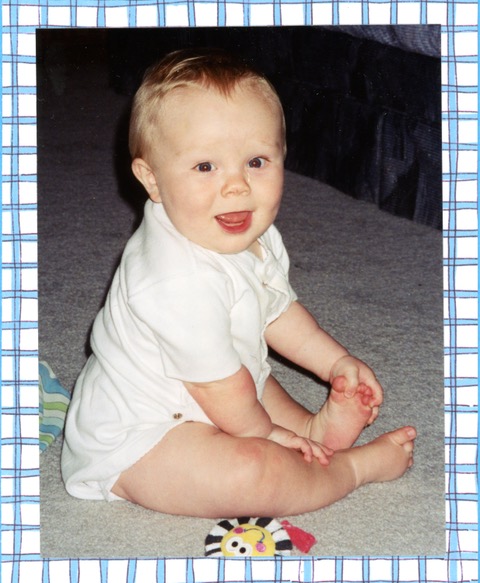
SOCIALIZING/PLAYING
- Has a social smile
- Cries when parents leave the room
- Laughs when playing with objects
- Establishes eye contact
- Watches his hands
- Plays with his fingers when hands are together
- Smiles or coos at himself when in front of a mirror
- Smiles when seeing you nearby before you smile or talk to him
- Waves arms toward a toy dangling above when lying on his back
- Likes to chew and pat books
- Focuses on large and bright pictures in a book
- Shares books with an adult as routine part of life
UNDERSTANDING
- Moves eyes in direction of sounds
- Notices toys that make sounds
- Pays attention to music
- Responds to the changes in the tone of your voice
- Follows a toy (about 25 cm away) with eyes when the toy moves slowly (side to side or up and down) in front of his face
- When you put a toy in baby’s hand, it goes into his mouth
TALKING
- Babbles to gain attention and express demands
- Coos and babbles when playing alone or with you
- Makes speech-like babbling sounds, like ‘da, ga, ka, pa, ba, mi’
- Giggles and laughs
- Makes sounds when happy or upset
- Makes high-pitched squeals
- Makes grunting, growling, or other deep-toned sounds when playing with sounds
EATING/SWALLOWING
- Anticipates feeding upon sight of bottle
- Takes 6-7 ounces of liquid per feeding; 4-5 bottles per day (by 4 months)
- Uses a sucking pattern
- Sequences 20 or more sucks; swallowing follows sucking with no discernable pauses when hungry; good coordination of suck/ swallow/breathe sequence (3 to 4 months)
- Tongue thrust reflex starts to disappear (4 months)
- Mouth opens when spoon approaches
- Begins to transfer from the front of his tongue to the back to swallow
- Takes 7-8 ounces of liquid per feeding; 3-4 bottles per day (by 6 months)
- Uses early bite-release pattern on soft cookie; biting rhythm is regular with no controlled, sustained bite; may revert to sucking cookie instead of biting (5 to 6 months); may use intermittent up/down chewing movements
CONTACT YOUR SPEECH LANGUAGE PATHOLOGIST IF YOU SEE
- Your baby does not respond to your smiles or interactions
- Your baby is not responding to sound
- Your baby is not babbling
- Baby has stopped babbling
- Baby is not playing with sounds
- Feeding times are more than 30 minutes
- Recurring pneumonia or respiratory infections
- Gurgly, hoarse, or breathy voice
- Less than normal weight gain or growth
Contact us or Go to top of page
6-9 Months
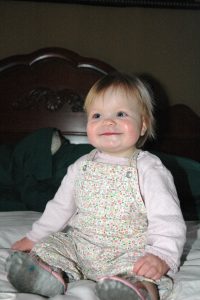
SOCIALIZING/PLAYING
- Smiles and pats image of herself in mirror
- Looks and reaches for what she wants
- Plays pat-a-cake and peek-a-boo games
- Copies simple actions of others
- Listens to songs and stories for a short time
- Plays by grabbing foot when lying on her back
- Picks up a toy and puts it in her mouth
- Plays by banging a toy up and down on floor or table
- Passes a toy back and forth from one hand to the other
- Likes to chew and pat books
- Can focus on large and bright pictures in a book
- Shares books with an adult as routine part of life
UNDERSTANDING
- If you are out of sight and call your baby, she looks in the direction of your voice
- Understands and responds to her own name
- Turns and looks in the direction of loud sounds
- Looks when you point
- Recognizes words for familiar objects and people
- Points to learn new vocabulary
- Responds to tone of your voice and will briefly stop activity when you say ‘no-no’
- Comprehends parental gestures
TALKING
- Makes high-pitched squeals
- Vocalizes differently for different emotional states (e.g., anger, contentment, hunger)
- Makes grunting, growling, or other deep-toned sounds when playing with sounds
- Makes sounds like ‘m, n, t, d, b, p, z’, ‘da’, ‘ga’, ‘ka’, and ‘ba’ while babbling
- Coos and squeals for attention
- Babbles a lot using long and short groups of sounds (e.g., ‘mimi’, ‘upup’, ‘bababa’)
- Uses a song-like intonation pattern when babbling
- Laughs when playing with objects
- Tries to communicate by actions and gestures (e.g., waving, reaching, or shaking head no, etc.)
- Imitates different speech sounds
- If you copy the sounds baby makes, baby will repeat the same sounds back to you
EATING/SWALLOWING
- Reaches for a spoon when presented
- Bangs a spoon
- Drinks from a cup held by adult; some loss of liquid
- Long sequences of sucking, swallowing, and breathing. With cup drinking, may have continuous sucks followed by uncoordinated swallowing; much liquid lost. Larger mouthfuls by cup may result in coughing or choking.
- Chewing begins
- Thicker pureed foods (7 months); ground or junior foods and mashed table foods (8 months)
- Feeds herself crunchy dissolvable solids (e.g., rice rusks)
CONTACT YOUR SPEECH LANGUAGE PATHOLOGIST IF YOU SEE
- Your baby does not respond to your smiles or interactions
- Your baby has had several ear infections
- Your baby does not babble
- Your baby does not try to talk
- Your baby has stopped babbling
- Baby has difficulty accepting new textures
- Prolonged feeding times
- Excessive leakage of food or liquid from baby’s mouth
- Baby is coughing, gagging, or throwing up during or after meals
- Baby is stuffing mouth with food
- Baby is pocketing food in mouth for prolonged period of time
9-12 Months
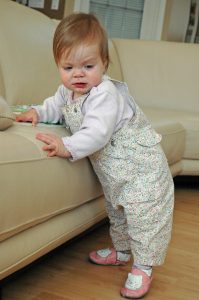
SOCIALIZING/PLAYING
- Bangs a toy in his hand against another toy on the table
- Passes a toy back and forth from one hand to the other
- Puts his foot in his mouth while baby is on back
- Finds a toy after watching you hide the toy under a cloth or paper
- When you hold out your hand and ask for a toy, baby will offer it to you even if he doesn’t let go of it
- Vocalizes to mirror
- Likes to chew and pat books
- Can focus on large and bright pictures in a book
- Shares books with an adult as routine part of life
UNDERSTANDING
- Understands more words than he says
- Understands meaning of ‘hot’
- Responds to simple directions regarding body action (e.g., ‘come here’ or ‘give it to me’) without gestural cues
- Points to learn new vocabulary
- Responds to tone of your voice and will briefly stop activity when you say ‘no-no’
- Responds to simple questions with searching movements
- When surrounded by objects shows awareness of more than one object
TALKING
- Vocalizes during play
- Jabbers loudly with a wide variety of sounds and intonations
- Understands the idea of conversation, and even if words are not recognizable, he will ‘chat’ with appropriate voice inflections
- Says a syllable or sequence of sounds repeatedly (e.g., ‘kakakaka’)
- Laughs when playing with objects
- Tries to communicate by actions and gestures (e.g., waving, reaching, or shaking head no)
- Imitates different speech sounds
- Begins to change babbling to jargon (made up words that almost sound like real speech)
- Combines different syllables in vocal play
- Says 1 or 2 words, such as hi, dog, dada, mama or uh-oh (around first birthday)
- If you copy the sounds baby makes, baby will repeat the same sounds back
- Shouts to attract attention
EATING/SWALLOWING
- Has longer sequences of continuous sucks with cup drinking; still has difficulty coordinating sucking, swallowing, and breathing with cup drinking.
- Holds a soft cookie between teeth without biting all the way through (9 months)
- Bites through soft cookies (12 months)
- Eats lumpy mashed food
- Starts chewing using rotary jaw action
- Drinks from a cup helped by caregiver
- Uses lips to remove food from spoon (10 months) Independent finger feeding
- Transitioning to soft table foods
- Is using the bottle or a pacifier less and less
CONTACT YOUR SPEECH LANGUAGE PATHOLOGIST IF YOU SEE
- Your baby does not respond to your smiles or interactions
- Your baby has had several ear infections
- Your baby does not use jargon
- Your baby does not try to talk
- Your baby has stopped babbling
- Your baby has not transitioned to table foods
- Prolonged feeding times
- Excessive leakage of food or liquid from baby’s mouth
- Baby is coughing, gagging, or throwing up during or after meals
- Baby is stuffing mouth with food
- Baby is pocketing food in mouth for prolonged period of time

SOCIALIZING/PLAYING
- Smiles and pats image of herself in mirror
- Plays pat-a-cake and peek-a-boo games
- Copies simple actions of others
- Shows a great deal of affection with parents
- Laughs a great deal
- Listens to songs and stories for a short time
- Helps turn the pages of a book
- Can focus on large and bright pictures in a book
- Shares books with an adult as routine part of life
- When you hold out your hand and ask for toy, baby will release toy into your hand
- Plays with doll or stuffed animal by hugging it
- Drops small toys into containers
UNDERSTANDING
- Understands ‘no’
- Recognizes her name when she hears it
- Points to show interest in something
- Follows simple directions, especially with a gestural cue
- Understands simple questions/ statements (e.g., ‘where is your nose’ and ‘give me’) without using gestural cues
- Hears well and discriminates between many sounds
- Receptive vocabulary of 50 words
TALKING
- Uses speech intentionally for the first time
- Words are usually used to label (e.g., mamma, dada, etc.)
- Expressive vocabulary grows from a handful of words (1 to 3) to a small number of single words (10 to 20)
- Some words are simplified versions of the adult word (e.g., ‘baba’ means bottle)
- The same word may have a different meaning in a different context
- Imitates familiar words (e.g., puppy, bottle, etc.)
- Makes the ‘sounds’ of familiar animals and things (e.g., woof, brrmmm, etc.)
- Waves bye-bye
- Nods ‘yes’ and shakes head for ‘no’
- Points at objects
EATING/SWALLOWING
- Grasps a spoon with a full hand
- Brings a full spoon to mouth, turning spoon over on route
- Begins to drink through a straw
- Holds a cup with two hands
- Holds and tips bottle by self
- Bottle weaning begins
- Drinks with four or five consecutive swallows
- Finger feeds self
- Eating an increasing variety of foods
- Pacifier weaning (if she has been using one). Limit pacifier use to bed or nap time.
- Child is not sucking thumb or fingers
SPEECH & FLUENCY
- You can understand about 25% of what child says
- Often omits the final sound of a word
CONTACT YOUR SPEECH LANGUAGE PATHOLOGIST IF YOU SEE
- Your child does not interact with others
- Your child has had several ear infections
- Child does not understand simple instructions
- You cannot understand anything your child says
- Your child does not talk at all
- Child is using mostly vowels
- Child does not imitate familiar words
- Your child has not transitioned to table foods
- Your child has recurring pneumonia or respiratory infections
- Your child has difficulty coordinating breathing with eating or drinking
- Child frequently spits up
- Child has less than normal weight gain or growth
1-1 1/2 Years
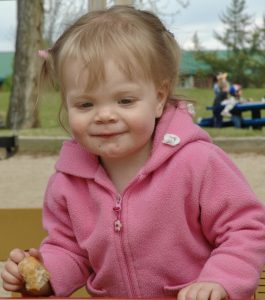
SOCIALIZING/PLAYING
- Takes part in imaginative play (e.g., pretending to go to sleep, putting toy phone to ear, etc.)
- Plays with doll or stuffed animal by hugging it
- Drops small toys into containers
- Gets your attention or tries to show you something by pulling on your hand or clothes
- Offers a toy to his own image when looking in a mirror
- Comes to you when he needs help
- Imitates adult behaviours in play
- Talks to himself during play
- Shares books with an adult as routine part of life
- Scribbles with crayons
- Rapid shifts in attention
UNDERSTANDING
- Recognizes pictures of familiar persons and objects
- Understands simple questions (e.g., ‘where is mommy/daddy’ and ‘where is your shoe?’)
- Points to 3 body parts (‘toes, eyes, nose’) when asked
- Points to objects he recognizes
- Repeats actions that made someone laugh
- Engages in parallel play
- Follows simple spatial directions (‘in’ and ‘on’)
- Understands ‘another’
- Engages in simple pretend play (e.g., talking on a telephone)
- Receptive vocabulary of 200 or more words
TALKING
- Uses sentence-like intonation (i.e., jargon) and may copy your words (i.e., echolalia)
- Pairs gestures with words to make wants known (e.g., ‘more’ and ‘up’)
- Refers to himself by name
- Exhibits verbal turn-taking
- Protests by vocalizing ‘no’
- Says ‘bye’ and other social words (e.g., ‘hi’, ‘thank you’, ‘please’, etc.)
- Uses simple directional terms (e.g., ‘up’ and ‘down’, etc.)
- Vocabulary made up of mostly nouns with some action words that have ‘ing’ ending (e.g., ‘walking, playing, crying’, etc.)
- Uses words to make wants known
- Says about 50 words before he will start to combine words
- Says ‘all gone’
- Uses two-word sentences
- Vocabulary undergoes spurt to 200 words
EATING/SWALLOWING
- Child is no longer using a bottle, pacifier, or thumb sucking
- Uses a controlled, sustained bite; may pull head backward in slight extension to help with bite
- Can chew with lips closed (inconsistent)
- Gives up bottle
- Scoops food with a spoon and brings it to mouth with spillage
- Drinks from a cup with limited spillage
- Swallows with lip closure
- Self-feeds frequently
- Chews a broad range of food
- Has precise up/down tongue movement
SPEECH & FLUENCY
- Often omits the final sounds in words
- Can be unintelligible with the exception of some words
CONTACT YOUR SPEECH LANGUAGE PATHOLOGIST IF YOU SEE
- Your child does not interact with others
- Your child does not seem to understand simple instructions
- Child does not point to show things to others
- Your child does not talk
- Child uses more gestures than words
- Your child has not transitioned to table foods
- Your child has recurring pneumonia or respiratory infections
- Your child has difficulty coordinating breathing with eating or drinking
- Child frequently spits up
- Child has less than normal weight gain or growth
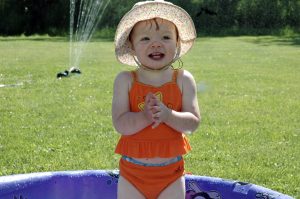
SOCIALIZING/PLAYING
- Repeats actions that made someone laugh
- Plays near others but not with them. Engages in parallel play
- Waves ‘bye-bye’
- When playing with a doll or stuffed animal, pretends to rock it, feed it, change its diaper, put it to bed, etc.
- Copies activities that you do (e.g., wiping up a spill, shaving, combing hair)
- Engages in simple pretend play (e.g., talking on a telephone)
- Recognizes certain books by their covers
- Listens to simple stories, songs, and rhymes
- Likes to turn pages (may grab a few at a time)
- Attends to a book or a toy for two minutes
- Points to and labels pictures independently
- Pretends to read books
- Scribbles back and forth when given a crayon
- Will get a chair or box to stand on if she wants something out of reach
UNDERSTANDING
- Points to pictures of familiar persons and objects
- Points to 5 body parts on self or doll
- Follows simple directions, especially with a gestural cue
- Understands simple questions and commands (e.g., ‘what’s this’, ‘get the car’, etc.)
- Follows directions using simple spatial concepts (‘in’, ‘on’, ‘under’)
- Understands ‘another’
- Understands ‘where is the ball’ by pointing to the pictured item in a book
- Listens as pictures are named
- Understands about 300 words
- Responds appropriately to yes/no questions with head nod/shake
TALKING
- Points and gestures to call attention to an event or to show wants
- Has 200 words
- Uses pronouns (I, it) and ‘ing’ verbs (e.g., crying, eating, etc.)
- Imitates two-word sentences
- Uses two or three prepositions ‘on’, ‘in’, or ‘under’
- Answers ‘what’s this?’ questions about familiar objects or pictures
- Combines two words (e.g., ‘up mommy’, ‘daddy gone’, or ‘no bed’)
- You can understand about 25 – 65% of what your child says
EATING/SWALLOWING
- Begins to bite through a variety of food thicknesses
- Starts to bring a spoon/fork to mouth, palm up; self-feeds with little spillage
- Starts to hold a small, open cup in one hand with little spillage
- Begins chewing with lips closed
- Begins chewing using stable rotary jaw action
- Swallows liquid from cup with easy lip closure; no loss of liquid
- Swallows solid foods (including a combination of textures) with easy lip closure; no loss of food
- Transfers food from one side of mouth to other side without pausing in center
- Stabilizes cup without biting edge
- Varying chewing movements (e.g., vertical and rotary)
- Child no longer uses bottle, pacifier, or sucks thumb
SPEECH & FLUENCY
- Imitates words and sounds more precisely
- Often omits end sound in words
- Substitutes easier sounds for more difficult ones (e.g., ‘tun’ for sun, ‘tea’ for key, etc.)
CONTACT YOUR SPEECH LANGUAGE PATHOLOGIST IF YOU SEE
- Your child does not interact with others
- Your child does not seem to understand simple instructions
- Your child does not talk
- Child uses more gestures than words
- You cannot understand what your child says
- Your child has difficulty eating table foods
- Your child has difficulty coordinating breathing with eating or drinking
- Child frequently spits up
- Child has less than normal weight gain or growth
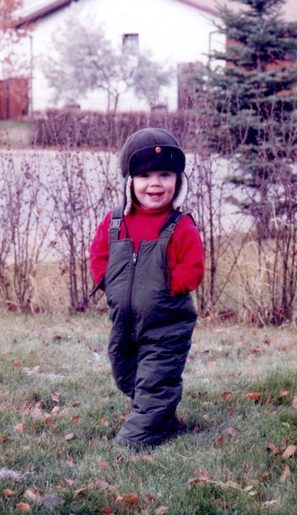
SOCIALIZING/PLAYING
- Pretends items are something else (e.g., holds a cup to ear and pretends its a phone)
- Will find a chair or box to stand on if she wants something out of reach
- Repeats actions that made someone laugh
- Watches other children and briefly joins in their play
- Carries on a conversation with himself and dolls
- Likes to hear the same story over and over
- Holds a book correctly
- Begins to recognize logos (e.g., McDonald’s golden arches or the Canadian Tire triangle, etc.)
- Begins to show a difference in writing versus drawing
UNDERSTANDING
- Points to pictures named in books
- Follows simple directions especially with a gestural cue
- Understands simple questions and commands (e.g., ‘what’s this’ or ‘get the car’)
- Recognizes body parts
- Understands concepts ‘one’ and ‘all’
- Begins to understand time concepts (e.g., soon, later, wait, last night, tomorrow)
- Recognizes objects that are the same
- Recognizes an object that is not the same as others
- Follows two-part commands
- Holds up fingers to tell age
- Understands 500-900 words
TALKING
- Uses:
- Pronouns (I, it)
- ‘ing’ verbs (e.g., crying)
- simple directional terms ‘up, down’
- two or three prepositions ‘on, in, under’
- ‘no’ or ‘not’ in his speech
- Begins to use:
- regular plurals (nouns + ‘s’ e.g., socks)
- adjectives for colour and size
- Says ‘no’ even when he means ‘yes’
- Answers ‘where’ and ‘what…doing’ questions
- Begins asking ‘why’
- Combines nouns and verbs (e.g., ‘dog runs’)
- Expressive vocabulary grows to 300 words or more
- Sentences are three to four words long
EATING/SWALLOWING
- Bites through a variety of food thicknesses
- Brings a spoon/fork to mouth, palm up
- self-feeds with little spillage
- Holds a small, open cup in one hand with little spillage
- Chews with lips closed
- Chews using stable rotary jaw action
SPEECH AND FLUENCY
- “Stutters” when excited (sometimes)
- You can understand about 50-75% of what your child says
- Often omits end sound in words (e.g., ‘bo’ for boat)
- Substitutes easier sounds for more difficult ones
- reduces sound clusters (e.g., ‘no’ for snow and ‘bu’ for blue)
- Consistently produce: p, b, m, n, w, h, d, k, g, ng, and f sounds
CONTACT YOUR SPEECH LANGUAGE PATHOLOGIST IF YOU SEE
- Your child does not interact with others
- Your child does not seem to understand simple instructions
- Child does not point to show things to others
- Your child shows frustration when trying to talk
- Child does not say two words together
- Your child has difficulty eating table foods
- Your child’s speech is difficult for you to understand
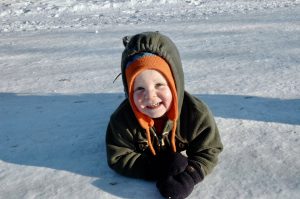
SOCIALIZING/PLAYING
- Make believe and pretend play begins (e.g., holds a cup to ear and pretends it’s a phone)
- Cooperative play begins
- Will find a chair or box to stand on if she wants something out of reach
- Likes to listen to books/stories for longer periods of time
- Can focus on toy or activity for four minutes
- Likes to hear the same story over and over
- Holds a book correctly
- Begins to recognize logos (e.g., McDonald’s golden arches or the Canadian Tire triangle, etc.)
- Begins to show a difference in writing versus drawing
UNDERSTANDING
- Points to pictures named in books
- Understands:
- number concepts ‘one, two, many’
- time concepts ‘soon, later, wait, last night, tomorrow’
- size differences (e.g., big/little)
- ‘est’ comparisons (e.g., biggest)
- position concepts (‘in, off, on, under, out of, together, away from’
- Recognizes body parts
- Recognizes objects that are the same
- Recognizes an object that is not the same as others
- Follows two-part commands
- Holds up fingers to tell age
- Points to objects when described by their use (e.g., what do you wear on your head?)
- Understands ‘can you’ questions
- Understands about 900 words or more
TALKING
- Uses:
- pronouns ‘I, it, me, mine, you’
- verb tense ‘is/am + ing’ (e.g., girl is running)
- possessives ‘noun + ‘s’ (e.g., daddy’s car)
- adjectives for colour and size
- Emerging:
- pronouns ‘he’ and ‘she’
- regular past tense ‘ed’ (e.g., walked)
- future verbs ‘do, can, will’
- regular plurals ‘noun + s’ (e.g., socks)
- verb form ‘gonna, gotta, wanna’
- May over generalize regular past tense ‘ed’ (e.g., says ‘I runned’ instead of ‘I ran’)
- Answers simple ‘wh’ questions logically (e.g., where, what’s that, who is, why, and how many)
- Asks ‘where, what, what…doing’ questions
- Combines nouns and verbs (e.g., ‘dog runs’)
- Says first name
- Talks to other children as well as adults
- Names common pictures and things she comes in contact with regularly
- Tries to get adult attention by saying ‘watch me’
- Expressive vocabulary grows to 500 words or more
- Sentences are three to four words long
EATING/SWALLOWING
- Bites through a variety of food thicknesses
- Brings a spoon/fork to mouth, palm up
- Self-feeds with little spillage
- Holds a small, open cup in one hand with little spillage
- Chews with lips closed
- Chews using stable rotary jaw action
- Eats same food as the rest of her family
SPEECH AND FLUENCY
- Consistently produce: p, b, m, n, w, h, t, d, k, g, ng, f, and y sounds
- “Stutters” when excited (sometimes)
- You can understand about 50-75% of what your child says
- Often omits end sound in words (e.g., ‘do’ for dog)
- Substitutes easier sounds for more difficult ones
- t for s (e.g., ‘tun’ for sun)
- w for r (e.g., ‘wabbit’ for rabbit)
- w for l (e.g., ‘wip’ for lip)
- d for z (e.g., ‘debra’ for zebra)
- f for th (e.g., ‘fum’ for thumb)
- d for th (e.g., ‘dis’ for this)
- reduces sound clusters (e.g., ‘pay’ for play)
CONTACT YOUR SPEECH LANGUAGE PATHOLOGIST IF YOU SEE
- Your child does not interact with others
- Your child does not seem to understand simple instructions
- Child does not point to show things to others
- Your child shows frustration when trying to talk
- Child does not say two words together
- Your child’s speech is difficult for you to understand
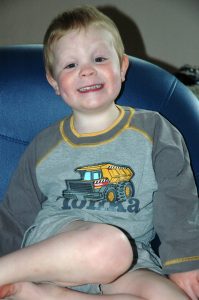
SOCIALIZING/PLAYING
- Begins to play house
- Begins to share
- Participates in simple group activities
- Engages in simple, make-believe activities
- Holds up fingers to tell age
- Looks for missing toys
- Helps put things away
- Stays with one activity 3 to 8 minutes when working alone
- Recognizes certain books by their covers
- Listens to simple stories, songs, and rhymes
- Likes to turn pages
- Attends to a book or a toy for two minutes
- Points to and labels pictures independently
- Will tell you what is happening in books
- Pretends to read books
- After drawing a picture, will tell you what he drew
- Counts 3 objects as he points to each one
UNDERSTANDING
- Understands new:
- position words ‘in front’ and ‘behind’
- time concepts ‘day, night, yesterday, summer, lunchtime’, and ‘tonight’
- descriptive words ‘hard’, ‘soft’, ‘rough’, and ‘smooth’
- Begins to follow prepositional phrases (e.g., ‘put the block under the chair’)
- Identifies circle and square
- Responds to commands involving two actions
- Responds to commands involving two objects
- Knows first and last name
- Knows several nursery rhymes or sings songs
- Has a 1200 word or more receptive vocabulary
TALKING
- Uses new:
- pronouns you, your, she, he, yours, and we
- contracted modals won’t and can’t
- irregular verbs hit and hurt
- irregular plurals child/children
- adjectives for colour and size
- Consistent use of:
- regular plurals ‘noun +-s’ (e.g., socks)
- possessives ‘noun + ‘s’ (e.g., girl’s hat)
- Third person singular verbs emerge (e.g., he runs)
- Requests permission for items or activities
- Begins to use language for fantasies, jokes, and teasing
- Makes conversational repairs when listener does not understand
- Engages in longer dialogues
- Carries on ‘conversation’ with self and dolls
- Begins to control behavior verbally rather than just physically
- Tells a simple story or relays an idea to someone
- Expresses fatigue verbally (e.g., ‘I tired’)
- Asks ‘what’ and ‘who’ questions frequently
- Uses compound sentences with ‘and’
- Responds appropriately to ‘how’ questions
- Expressive vocabulary grows to 800-1000 words or more
- Uses 4 to 5 words in a sentence
SPEECH AND FLUENCY
- Consistently produce: p, b, m, n, h, w, y, t, d, f, k, g, ng, s, l, and sh sounds
- You can understand about 75 – 100% of what child says
- Replaces harder sounds with easier ones:
- b for v (e.g., ‘bacuum’ for vacuum)
- w for r (e.g., ‘wabbit’ for rabbit)
- t for ch (e.g., ‘tair’ for chair)
- d for z (e.g., ‘debra’ for zebra)
- f for th (e.g., ‘fum’ for thumb)
- d for th (e.g., ‘dis’ for this)
- Uses final consonants most of the time
- “Stutters” less frequently Shows some normal dysfluencies for his age (e.g., repeating sounds ‘l-l-l-like, words ‘like-like-you’ and phrases ‘I want, I want, I want to go
CONTACT YOUR SPEECH LANGUAGE PATHOLOGIST IF YOU SEE
- Your child has difficulty playing imaginary games with others
- Child is not enjoying social interactions with peers
- Your child echoes back questions instead of answering the question
- Child does not follow a two-step command
- Your child is not puttng 3 to 5 words together in a sentence
- Child does not ask ‘why’ questions
- Child is not using basic grammar
- Your child’s speech is difficult for strangers to understand
- Child gets frustrated by not being understood.
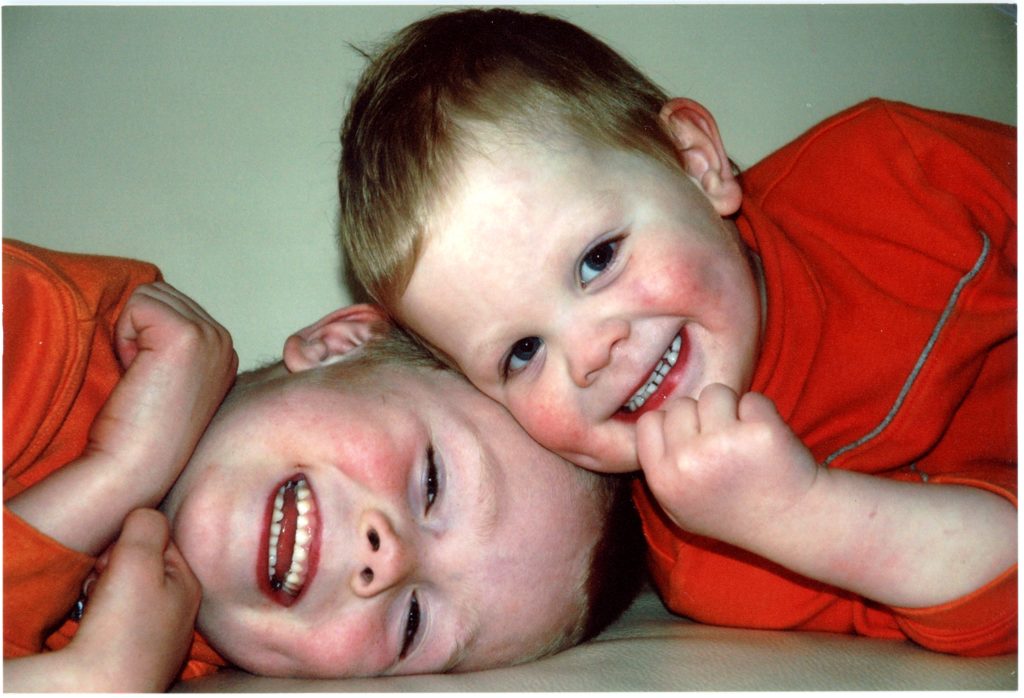
SOCIALIZING/PLAYING
- Increase in dramatic play
- Suggests taking turns, but is often bossy
- Stays with different activities for 11-15 minutes if its interesting
- Can correctly answer the question ‘are you a boy or a girl’
- Dresses up and pretends to be someone or something else in play
- Separates from primary caregiver easily
- Begins to pay attention to specific print (e.g., the first letter of name)
- Recognizes logos and other environmental print and understands that print carries a message
- Identifies some letters and makes letter sound matches
- Participates in rhyming games
- Talks about characters in a book
- Likes to ‘read’ stories to herself and others
- Protests if adult changes the story
- Produces some letter-like forms in scribbles that resemble letters
- Knows first and last name
UNDERSTANDING
- Follows two-step related directions without cues
- Takes turns and plays cooperatively
- Begins dramatic play, acting out whole scenes
- Points to colours red, blue, yellow, green
- Identifies shapes cross, triangle, circle, square
- Points to object that is different from others
- Follows requests even though objects may not be present (e.g., ‘bring me the cup’)
- Follows two related directions (e.g., ‘close the book and give it to me’)
- Begins to follow three unrelated directions (e.g., ‘give me the pen, open the book and stand up’)
- Understands comparisons (e.g., ‘which circle is the smallest’)
- Has a 2000 word or more receptive vocabulary
TALKING
- Uses consistently:
- pronouns I, he, she, you, me, and mine
- verb tense ‘is + ing’ (e.g., is walking)
- regular past (e.g., walked)
- semi-auxiliaries gonna, gotta, wanna
- ‘can, will, be, do’
- irregular verbs ‘went’
- possessives ‘noun + ‘s’ (e.g., girl’s hat)
- third person (e.g., it runs)
- contractions (e.g., it’s or there’s)
- Pronouns they, their, and myself are emerging
- Relates personal experiences through verbalization
- Frequently practices conversation skills by talking to herself
- Shows frustration if not understood
- Expresses ideas and feelings
- Uses position concepts ‘behind’, ‘in front’, and ‘around’
- Begins to use complex sentences
- Speaks of imaginary conditions (e.g., ‘suppose that’ or ‘I hope’)
- Asks ‘who, why, where how’ questions
- Asks many questions although more interested in how the answers fit her own thoughts rather than just the explanation
- Answers more complex ‘who, why, where, how’ questions logically
- Answers questions about functions of objects (e.g., ‘what are spoons for’ and ‘why do we have shoes’)
- Answers ‘if…what’ questions (e.g., ‘if it starts raining, what would you do?’)
- Describes what is happening in a picture
- Expressive vocabulary grows to 1500 words
- Uses 4 to 7 words in a sentence
SPEECH AND FLUENCY
- Consistently produces: p, b, m, n, h, w, y, t, d, ng, k, g, f, l, s, sh, z, v, ch, and j sounds
- You can understand about 75 – 100% of what child says, although errors may still be present
- May have difficulty with multi-syllabic words (e.g., says ‘ambeence’ for ambulance’)
- Still has some cluster reduction (e.g., ‘no’ for snow, ‘bu’ for blue, ‘tee’ for tree)
- Replaces harder sounds with easier ones:
- w for r (e.g., ‘wabbit’ for rabbit)
- f for th (e.g., ‘fum’ for thumb)
- d for zh (e.g. ‘meduh’ for measure)
- d for th (e.g., ‘dis’ for this)
CONTACT YOUR SPEECH LANGUAGE PATHOLOGIST IF YOU SEE
- Your child has difficulty playing imaginary games with others
- Your child has difficulty following directions
- Your child cannot answer who or what questions
- Your child’s speech is difficult for strangers to understand
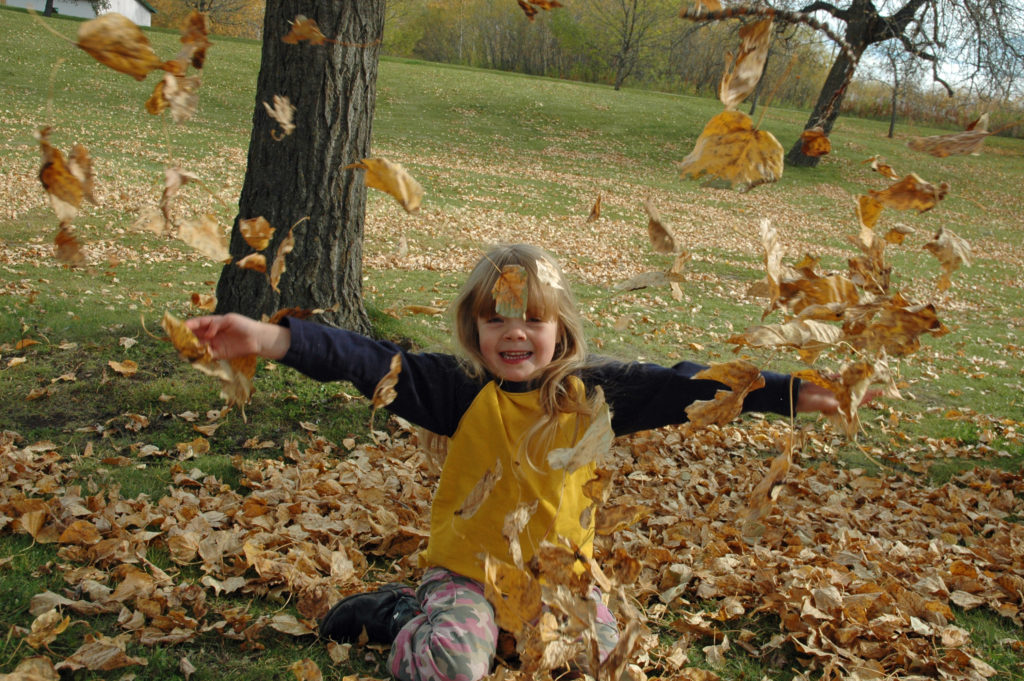
SOCIALIZING/PLAYING
- Stays with a single activity for 7-8 minutes and up to 15 minutes if it is interesting or new
- Dresses up and pretends to be someone or something else in play (e.g., a mommy, daddy, brother, imaginary animal, etc.)
- Uses words to invite others to play
- Begins to pay attention to specific print (e.g., letters in his name)
- Recognizes logos and other environmental print and understands that print carries a message
- Identifies some letters and makes letter sound matches
- Talks about characters in a book
- Likes to ‘read’ stories to himself and others
- Protests if adult changes the story
- Produces some letter-like forms in scribbles that resemble letters
- Rote counts to 10
- Counts 4 objects
- Good imaginative play
UNDERSTANDING
- Understands concept of the number three (e.g., ‘just give me three blocks’)
- Knows ‘above, below, top, bottom’
- Understands ‘next to, beside, between’
- Understands ‘first, next, last’
- Follows directions with quantity concepts (e.g., empty, a lot)
- Follows directions with equality concepts (e.g., same, both)
- Matches one-to-one
- Has a 2500 word or more receptive vocabulary
TALKING
- Uses consistently:
- pronouns ‘our, they, their’
- ‘could, would, should, must, might’
- past tense verb ‘was/were + ing’ (e.g., she was dancing)
- irregular past tense verb ‘saw’
- irregular 3rd person singular verb (e.g., she drinks juice)
- articles ‘a, the’
- irregular plurals ‘mouse/mice’
- Over generalization of regular past tense (e.g., I runned)
- ‘If’ and ‘so’ appear in sentences
- Frequent errors involving noun/verb and adjective/noun agreement (e.g., ‘she haves’ or ‘I want two cookie’)
- Names three items from a common category (e.g., things you eat, animals)
- Answers ‘when’ questions
- Answers ‘how many’ questions (as long as the answer is not higher than four)
- Begins to use complex sentences
- Speaks of imaginary conditions (e.g., ‘suppose that’ or ‘I hope’)
- Expressive vocabulary grows to 1600 words or more
- Uses 4 to 7 words in a sentence
SPEECH AND FLUENCY
- Consistently produces: p, b, m, n, h, w, y, t, d, k, g, ng, f, v, s, z, l, sh, ch, j, zh, and r sounds
- You can understand about 100% of what child says, although errors may still be present
- May have difficulty with multi-syllabic words (e.g., ‘hopsital’ for hospital)
- Replaces harder sounds with easier ones:
- f for th (e.g., ‘fum’ for thumb), and
- d for th (e.g., ‘dis’ for this)
CONTACT YOUR SPEECH LANGUAGE PATHOLOGIST IF YOU SEE
- Your child has difficulty playing imaginary games with others
- Your child is not engaging in appropriate social interactions with other kids
- Child is not telling stories you can easily follow (with a beginning, middle, and end)
- Child does not pay attendtion to stories
- Child cannot answer questions about stories
- Your child does not use and understand time concepts (e.g., yesterday/tomorrow)
- Your child is not talking in complete sentences
- Child is not using mostly adult-like grammar
- Child has a limited vocabulary
- Your child’s speech is difficult for strangers to understand
- Your child is stuttering
- Child gets frustrated when not understood

SOCIALIZING/PLAYING
- Stays with an activity for 11-12 minutes
- Stays with an activity chosen by an adult for 2-3 minutes
- Can correctly answer the question ‘are you a boy or a girl’
- Uses language to resolve disputes with peers
- Dresses up and pretends to be someone or something else in play (e.g., a mommy, daddy, brother, imaginary animal, etc.)
- Separates from primary caregiver easily
- Plays in groups of 2 to 5
- Definite interest in finishing what he started
- Knows first and last name
- Understands story sequence
- Understands the function and purpose of print
- Knows many letter names
- Uses more letter-like forms than scribbles
- Can count 10 objects
UNDERSTANDING
- Follows three-step unrelated directions without clues (e.g., ‘give me the pen, open the book and stand up’)
- Points to red, yellow, green, and blue on request
- Knows ‘heavy/light, loud/soft, like/unalike’ and discriminates ‘long/short’
- Understands comparative and superlative adjectives (e.g., big/ bigger/ biggest)
- Understands time concepts ‘yesterday, today, tomorrow, first, then, next, days of week, last week, next week’
- Understands ‘different, nearest, through, middle, thin, whole’
- Identifies positional concepts ‘first, middle, last’
- Plays competitive exercise games
- Has a 2800 word or more receptive vocabulary
TALKING
- Uses pronouns more consistently:
- possessives ‘his, her’
- reflexive ‘myself, himself, herself’, etc.
- Uses contractible auxiliary (e.g., the boy’s talking)
- Uses irregular past verbs ‘gave, ate’
- Uses direct requests with justification (e.g., ‘stop that, you’re hurting me’)
- Uses words to invite others to play
- Uses language to resolve disputes with peers
- Has good control of the elements of conversation
- Speaks of imaginary conditions (e.g., ‘what if…’ or ‘I hope’)
- Can tell you two things about common objects
- Uses the comparative -er ending (e.g., bigger)
- Expressive vocabulary grows to 1900 words or more
- Uses sentences up to 8 words
SPEECH AND FLUENCY
- Consistently produces: p, b, m, n, h, w, y, t, d, k, g, ng, f, v, s, z, l, sh, ch, j, zh, r, s blend, l blend, and r blend sounds
- You can understand about 100% of what child says, although errors may still be present
- May have difficulty with multi-syllabic words (e.g., ‘psgetti’ for spaghetti)
- Replaces harder sounds with easier ones:
- f for th (e.g., ‘fum’ for thumb)
- d for th (e.g., ‘dis’ for this)
CONTACT YOUR SPEECH LANGUAGE PATHOLOGIST IF YOU SEE
- Your child has difficulty playing imaginary games with others
- Your child does not seem to be able to follow directions
- Your child does not use complete and grammatically correct sentences
- Your child’s speech is difficult for strangers to undersand
- Your child stutters
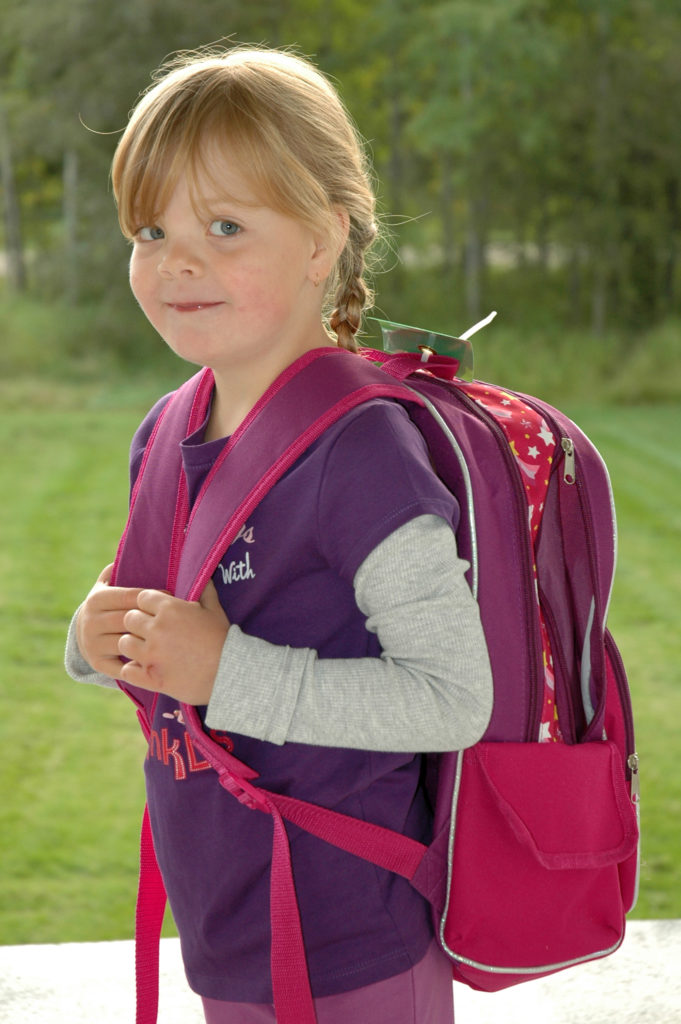
SOCIALIZING/PLAYING
- Stays with an activity for 12-15 minutes
- Stays on an assigned task 4-6 minutes if its easy and interesting
- Can rote count to 30
- Counts 12 objects correctly
- Can play games by the rules
- Retells simple stories
- Carries a plot in a story
- Identifies the first and last sounds in a word (not letter names)
- Can orally blend 3 sounds to make a word
- Can orally segment a three-sound word into its individual sounds
- Recognizes letters and letter-sound matches
- Understands that print is read left to right and top to bottom
- Begins to write letters and some words heard often
- Begins to write stories with some readable parts with assistance
- Tries to spell words when writing
UNDERSTANDING
- Understands spatial relations ‘on top, behind, far, near’
- Knows common opposites ‘big/little, hard/soft, cold/hot, up/down’
- Engages in cooperative play (e.g., making group decisions, assigning roles, and playing fairly)
- Receptive vocabulary of approximately 13, 000 words
TALKING
- Syntax is nearly normal
- Uses all pronouns consistently
- Uses most verb forms correctly
- Uses irregular past verbs ‘took, fell, broke, found, came, made, threw, sat’
- Uses threats and promises
- Asks meanings of words
- Asks questions for information
- Announces topic shifts
- Uses all types of sentences, some of which are complex
- Defines objects by their use and can tell what objects are made of
- Questions for information
- Uses superlatives -est ending (e.g., biggest)
- Expressive vocabulary grows to 2200 – 2500 words or more
- Uses 8 plus words in a sentence
SPEECH AND FLUENCY
- Consistently produces: p, b, m, n, h, w, y, t, d, ng, k, g, f, v, s, z, sh, ch, j, zh, l, r, l blend, s blend, and voiced th sounds
- You can understand about 100% of what child says, although minor errors may still be present
- Replaces harder sounds with easier ones:
- f for th (e.g., ‘fum’ for thumb)
CONTACT YOUR SPEECH LANGUAGE PATHOLOGIST IF YOU SEE
- Your child is having difficulty learning to read
- Child does not recognize words that start with the same sounds
- Child is not engaging in appropriate social interactions with other kids
- Your child is reluctant to answer questions in the classroom
- Child gets frustrated because he is having trouble understanding something
- Your child cannot explain how an object can be used
- Child is unable to answer when and why quesitons
- Child is not talking about past and future events
- Your child’s speech is difficult for strangers to understand
- Your child is stuttering

SOCIALIZING/PLAYING
- Stays with an activity for 15 minutes
- Understands what is read
- Predicts the next sequence of events and tells a 4 to 5 part story
- Rote counts to 100
- Identifies the first, last, and middle sounds in a word (not the letter names)
- Orally blends four or more sounds to make a word
- Can orally segment a four-sound word or more into its individual sounds
- Can delete sounds in a word to make a new word
- Can manipulate sounds in a word to make a new word
- Recognizes an increasing number of words by sight
- Identifies and writes uppercase and lowercase letters
- ‘Reads’ a few picture books from memory
- Prints own first and last name
- Begins to decode new words independently
- ‘Reads’ and retells familiar stories
- Sounds out and represents major sounds in words when trying to spell
UNDERSTANDING
- Understands the meaning of most sentences
- Understands most opposites
- Understands meaning of through, away, toward, and from
- Knows left and right
- Understands seasons of the year
- Understands number concepts to 20
- Follows three-step commands
- Receptive vocabulary of approximately 20,000 to 26,000 words
TALKING
- Uses all pronouns
- Fairly consistent use of most grammatical markers
- Answers ‘how are things the same/different?’
- Uses adjectives for describing
- Uses irregular past tense verbs ‘ran, flew, wore, wrote, cut, fed, drove, bit, blew, read, shot, rode’
- Uses ‘yesterday’ and ‘tomorrow’
- Uses adverb concepts ‘backward’ and ‘forward’
- Uses prepositions ‘through, nearest, corner, middle’
- Uses irregular comparatives ‘good, better, best’
- Irregular plurals continue to improve
- Names ordinal numbers (e.g., first, second, third)
- Uses adult-like grammar in sentences and conversation
- Expressive vocabulary is 2,600 – 7,000 words
- Asks lots of ‘why, what, how’ questions
- Uses 8 plus words in a sentence
SPEECH AND FLUENCY
- Consistently produces all speech sounds with the possible exception of voiceless ‘th’ which is emerging within this year
- You can understand about 100% of what child says
- May replace harder sounds with easier ones:
- f for th (e.g., ‘bafroom’ for bathroom
CONTACT YOUR SPEECH LANGUAGE PATHOLOGIST IF YOU SEE
- Your child is not engaging in appropriate social interactions with other kids
- Your child is having difficulties learning to read
- Your child is having trouble understanding
- Your child has difficulties following directions
- Your child is having difficulty with grammar
- Child has a limited vocabulary
- Your child’s speech is difficult for strangers to understand
- Your child is stuttering
